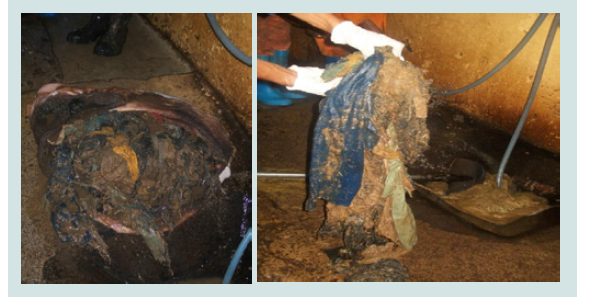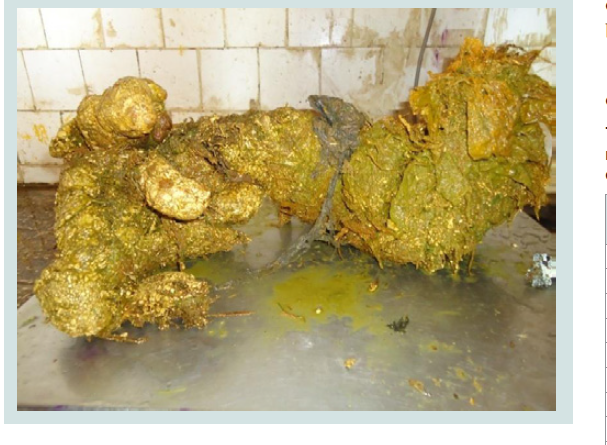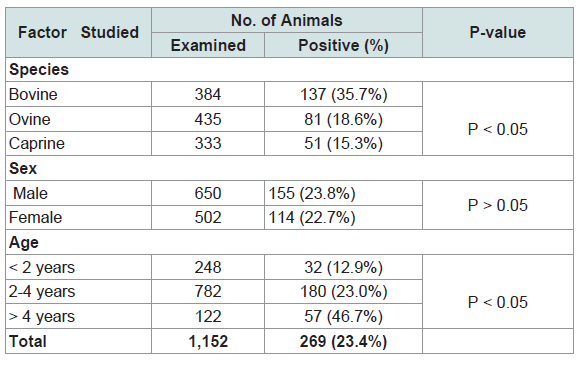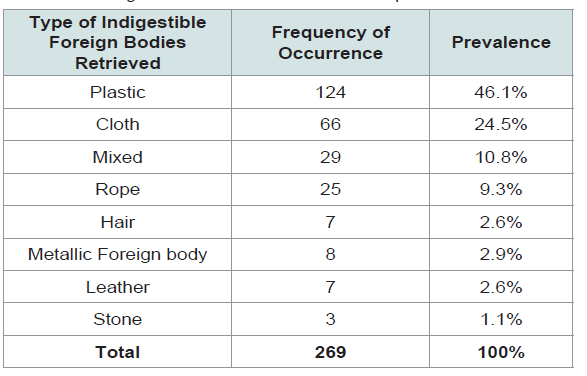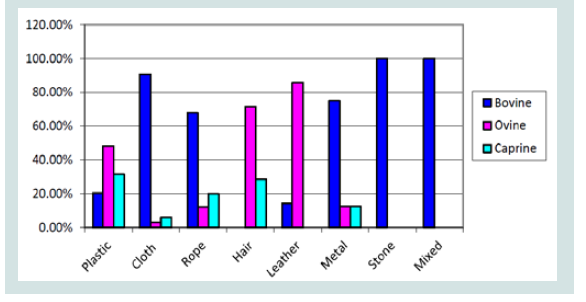Journal of Veterinary Science & Medicine
Download PDF
Research Article
Indigestible Rumen Foreign Bodies - Causes of Rumen Impaction in Cattle, Sheep and Goats Slaughtered at Addis Ababa Abattoir Enterprise, Ethiopia
Sitotaw Mekuanint1, Tewodros Alemneh2,4* and Tsegaye Asredie3
- 1Bole Sub-City Administration Trade Office, Urban Agricultural Extension Services, Addis Ababa, Ethiopia
- 2Woreta Town Administration Office of Agriculture and Environmental Protection, Woreta, Ethiopia
- 3Amhara Regional Agricultural Research Institute (ARARI), Gondar, Ethiopa
- 4Faculty of Veterinary Medicine, University of Gondar, Gondar, Ethiopia
*Address for Correspondence:Tewodros Alemneh, Faculty of Veterinary Medicine, University of Gondar, Gondar, Ethiopia, E-mail: tedyshow@gmail.com
Citation: Mekuanint S, Alemneh T, Asredie T. Indigestible Rumen Foreign Bodies - Causes of Rumen Impaction in Cattle, Sheep and Goats Slaughtered at Addis Ababa Abattoir Enterprise, Ethiopia. J Veter Sci Med. 2017;5(1): 5.
Copyright: © 2017 Alemneh T, et al. This is an open access article distributed under the Creative Commons Attribution License, which permits unrestricted use, distribution, and reproduction in any medium, provided the original work is properly cited
Journal of Veterinary Science & Medicine | ISSN: 2325-4645 | Volume: 5, Issue: 1
Submission: 01 March, 2017| Accepted: 03 April, 2017 | Published: 10 April, 2017
Abstract
A study was conducted at Addis Ababa abattoir to assess the prevalence of indigestible rumen foreign body impaction and to identify the causes in apparently healthy slaughtered cattle, sheepand goats. Out of the total 1,152 ruminants (384 cattle, 435 sheep and 333 goats) examined, 269 (23.4 %) were found infected. Of these 137 (35.7%) were cattle, 81 (18.6%) were sheep and 51 (15.3%) were goats. The prevalence was compared among species of animals and a significantly (p> 0.05) higher occurrence of foreign bodies was observed in cattle (35.7%) than sheep (18.6%) and goats (15.3%). The prevalence of foreign bodies in female and male ruminants was 22.7% and 23.8%, respectively (p> 0.05). Among the different age groups, significantly (p< 0.05) highest prevalence was observed in animals' of > 4 years old and the lowest was in animals' < 2 years old. The indigestible foreign bodies were plastic bags, cloth, ropes, leather, hairballs and metals. A plastic bag was detected at higher level with prevalence of 46.1% from the rumen. Results of this study indicated that the prevalence of rumen impaction in ruminants is quite high. Therefore, concerned body should work against contamination of the environment with foreign bodies in the study area.
Keywords
Ruminants; Indigestible foreign bodies; Rumen impaction; Prevalence; Abattoir study
Introduction
Ethiopia is believed to have the largest livestock population in Africa [1]. This livestock sector has been contributing considerable portion to the economy of the country and still promising to spearhead the economic development of the country. About 50.8 million cattle, 25.9 million sheep and 21.9 million goats' population are estimated to be in the country [1]. Cattle play significant contribution in Ethiopian economy as a source of meat, milk, drought power, income, and foreign exchange. Sheep and goats are major source of income (cash) for the rural poor farmers in most parts of tropics including Ethiopia. Furthermore, they play an important role in providing export commodities, such as live animals, hides and skins to earn foreign exchanges [1].
However, the full exploitation of these resources is hindered by a combination of factors such as drought, poor genetic potential and backward animal husbandry practices and diseases [2]. Ingestion of foreign bodies by ruminants is extremely common especially in developing countries, like Ethiopia, where the standard of animal management is unsatisfactory and low nutritional statuses of ruminants have forced them to scavenge for food [3]. In Ethiopia, ruminants are very likely to be exposed to ingestion of indigestible foreign bodies of various sources, as they are mainly reared in urban, sub-urban and kept under an extensive type of management [4].
The bovine species does not have highly sensitive prehensile organs, such as lips and tongue, nor are a discriminating sense of taste and ingestion and lodgment of foreign bodies common due to indiscriminate feeding habits [5]. It is generally accepted that sheep and goats are highly selective feeders and ingest significantly less amount of foreign bodies compared to cattle [6]. Cattle are inquisitive and tend to consume all sorts of objects while foraging. A retrospective study conducted on indigestible rumen foreign bodies in Gondar showed the serious impact of plastic bags in the health of cattle and its threat to the environment.
Hassan and Kikisagbe have also pointed out the health hazards associated with the use of polythene shopping bags which are thrownon rubbish dumps, road sides and virtually everywhere littering the environment to ruminants that are left to scavenge around most urban and peri-urban setting [7]. This pollution predicated as a growing problem for grazing animals because of the poor waste management system and inadequate availability of feed during the long dry season. Industrialization and mechanization of agriculture have further increased the incidence of foreign body ingestion in animals [3].
Reports from cattle and sheep reared in urban and sub-urban environments indicated that impaction of the rumen resulted from the accumulation of foreign bodies, such as plastic bags which interferes with the flow of ingesta leading to the distension of rumen and absence of defecation [8]. Indigestible foreign bodies in the reticulo-rumen cause recurrent rumen tympany in adult dairy cattle; trichobezoars have been found associated with acute rumen tympany in calves and young cattle (Schweizer et al. and Radostitis et al.) reported the problem to be a condition of great economic importance in cattle primarily due to indiscriminate feeding habits and causes severe loss of production and high mortality rates [9-11]. Al-majali et al. also reported that a large proportion of cattle with ingested foreignbody (plastics) in the rumen had displacement of abomasums and decrease in milk production [12].
The presence of foreign bodies in the rumen and reticulum also hampers the absorption of volatile fatty acids (VFA) and consequently reduction in the rate of animal fattening [13]. Furthermore, the presence of large amounts of foreign bodies in the reticulo-rumen may lead to alterations in the microbial populations of these digestive chambers, worsening the pathogenesis of the condition [14].
Some countries, notably Jordan, have estimated the losses in sheep productivity and health associated with rumen impaction as USD 25 million [6]. Recently, contamination of beef products from foreign objects like glass, metal, plastic or wood objects, found in meat led to a loss of millions of dollars [15]. Rumen impaction is asymptomatic in nature and is rarely diagnosed in live animal. It can only be adequately studied in abattoir [13]. Previous studies on indigestible rumen foreign bodies in ruminants were from different parts of Ethiopia and other parts of the world gave different results. Prevalence of 23.2% in sheep and goats at Addis Ababa abattoir [16], 6.1% in small ruminants at Luna export abattoir, East Shoa Zone [17], 13.22% in cattle at Jimma Municipal Abattoir, South West Ethiopia [8], 8.6% in ruminants at Gondar Town, North West Ethiopia [18], 11.6% in ruminants at Zango abattoir in Zaria, Kaduna State, Nigeria [19], 81% and 85% in live and slaughtered goats at Southern Darfur, Pakistan [20], 59.14% in cattle at different regions of Khyber Pakhtunkhwa [21], 17.4% in cattle at Ngoma Slaughterhouse, Rwanda [22] and 97% in small ruminants in Nigerian [23] was recorded.
In the study area, however, information regarding the magnitude and occurrence of rumen indigestible foreign bodies is very much limited. Therefore, the objective of the present study were to assess the prevalence of indigestible rumen foreign bodies in cattle, sheep and goats slaughtered at Addis Ababa abattoir enterprise and to identify the type of indigestible foreign bodies involved in rumen impaction and determine the factors associated with foreign bodies in ruminants slaughtered at Addis Ababa abattoir enterprise
Materials and Methods
Study area
The study was conducted at Addis Ababa abattoir enterprise on cattle, sheep and goats brought for slaughter from November 2010 to April 2011. Geographically, Addis Ababa is located at 9° 42` N and 38° 3` E with an elevation of about 2400 m above sea level. Addis Ababa receives a mean annual rainfall of 1800 mm in bimodal pattern. The long rainy season extends from June to September followed by a dry season ranging from October to February. The short rainy season lasts from March to May. The average minimum and maximum temperature are 10.7 °C and 23.6 °C respectively [24].
Study animals
The study was conducted on 1152 apparently healthy slaughtered cattle, sheep and goats of local breeds at Addis Ababa abattoir enterprise. Study animals were different species, age groups and both sexes. The animals, which were slaughtered at Addis Ababa abattoir enterprise, originated from different parts of the country, mainly from North Shewa of Amhara and Oromia region, Jimma, Gojjam, Wollo, East Shewa, Wellega, West Shewa, Afar, Soamli, Borna and Arsi. Animals were usually brought to the Addis Ababa market individually or in flocks on foot or by truck. The animals were purchased by restaurant owners and taken to Addis Ababa abattoir for slaughter.
Study design
A cross-sectional study was conducted to assess the prevalence and identify the types of foreign bodies present in the rumen and their associated risk factors. Species, age, sexes of the studied animals were considered as risk factors for occurrence of indigestible foreign bodies. Based on species, occurrence was recorded for bovine, ovine and caprine. Ages of studied animals were estimated using dentition pattern as described by De Loanta and Habel and categorized into two as young and adult. Sex was determined by observation of the genital organs [25].
Sample size determination
The sample size required for this study was determined based on sample size determination in random sampling for infinite population using expected prevalence of rumen indigestible foreign bodies in cattle, sheep and goats and the desired absolute precision according to Thrusfield as follows [26]:
where,
n = required sample size, Pexp = expected prevalence, d = desired absolute precision.
There was no previous study on prevalence of rumen foreign bodies of cattle slaughtered at Addis Ababa abattoir enterprise. The sample size for this study was determined using 50% expected prevalence. Therefore, using 50% expected prevalence and 5% absolute precision at 95% confidence level using the above formula, the sample size was determined to include 1,152 ruminants (cattle, sheep and goat) were examined.
Animal selection and postmortem examination
Animals were selected by simple random sampling and 1,152 ruminants were examined for the presence of indigestible foreignbodies in their rumen. From presented cattle, sheep and goats for slaughter, every fifth animal was selected for examination of foreign bodies in their forestomach. Selected animals would have been identified by species, sex and age, prior to slaughter. After slaughter, the stomach was carefully removed from the abdomen and the stomach opened and explored for the presence of any indigestible foreign body by visual inspection and palpation. Then the indigestible foreign body was removed, washed, dried and identified. When foreign bodies were detected, they were recorded as positive and categorized accordingly. In positive cases, rumen was found shrunken, appeared as if the ruminal wall was adhering to the faeces of strangulated foreign materials. Necrotic signs of ruminitis of ruminal pillars with congestion of the mucosa and ulceration were also detected.
Figure 1: Recently ingested mixed indigestible foreign bodies (plastics, cloth and rope).(a) In the rumen, (b) After removed from the rumen of an adult ox at Addis Ababa abattoir enterprise.
Figure 2: Ingested plastic foreign bodies retrieved from the rumen of four years old male goat at Addis Ababa abattoir enterprise
Data management and analysis
All raw data generated during postmortem examination were stored using computer based data management system employing MS excel and the analysis was conducted using SPSS software (version 15.0, 2008). Prevalence of indigestible foreign bodies were expressed as percentage by dividing total number of animals positive for indigestible foreign bodies to the total number of animals examined. The chi-square test (Χ2-test) was applied to test if there is any statistically significant association between risk factors such as species, sex and age and a difference was recorded as statistically significant if p-values were less than 0.05.
Results
Out of the total 1,152 ruminants examined for presence of indigestible rumen foreign bodies, 269 (23.4%) were found positive for different kinds of foreign bodies. From examined cattle, sheep and goats, 137 (35.7%), 81 (18.6%) and 51 (15.3%) were positive, respectively (Table 1 and Figures 1 and 2). There was statistically significant difference (p< 0.05) in the frequency of occurrence of foreign bodies between species (Table 1).
From 650 male and 502 female animals examined, foreign body was found in the rumen of 155 males (23.8%) and 114 females (22.7%) of the total ruminants examined (Table 1). There was no significant difference (p> 0.05) between female and male animals on the frequency of occurrence of foreign bodies (Table 1).
Age of examined animals was tested as risk factor for occurrence of indigestible rumen foreign bodies, and the highest frequency (46.7%) was observed in ruminants greater than four years, 23.0% was found between 2-4 years old and the lowest (12.9%) was observed in ruminants of age less than two years old (Table 1). However, there was statistically significance difference (p< 0.05) between frequencies of occurrence of foreign bodies among the different age groups (Table 1).
The type of foreign bodies found in slaughtered animals were plastic, cloth, mixed, rope, hair, metallic foreign body, leather and stone. Plastic bags was the most common as observed in 124 (46.1%) of the positive cases. There difference in the prevalence of foreign bodies was statistically significant (p< 0.05) (Table 2).The types of foreign bodies encountered and their frequency of occurrence with regards to the species of ruminants were studied. The prevalence of rumen impaction was highest in bovine compared within ovine and caprine (Table 3 and Figure 3).
Table 1: Frequency of occurrence of indigestible rumen foreign bodies in relation to species, sex and age of animals slaughtered at Addis Ababa abattoir enterprise.
Discussion
The present study showed an overall prevalence rate of 23.4% (n = 269) indigestible rumen foreign bodies in ruminants slaughtered at Addis Ababa abattoir enterprise. The prevalence rate in cattle, sheep and goats was 35.7% (n = 137), 18.6% (n = 81) and 15.3% (n = 51), respectively. Similar findings were reported in small ruminant slaughtered at Addis Ababa and Adama abattoirs that showed a prevalence rate of 23.2% [16] and 25.8% [27]. On other hand, Abebe and Nuru reported a lower prevalence rate (6.1%) in sheep and goats slaughtered at Luna Export Abattoir, Eastern Shewa [17]. The reason for the lower prevalence rate was stated to be the origin of animals and the difference in the sex composition as all the animals examined were males. On the contrary, Remi-Adewunmi et al. have reported a much higher prevalence rate (97%) in sheep and goats brought from urban areas of Nigeria for slaughter [23].
Retrospective study conducted in Gondar city of Ethiopia to observe the consequences of plastic bags usage on environment and cattle health showed the serious impact of plastic bags in the health of cattle and its threat to the environment. Similarly, the findings of the current study revealed the frequent occurrence of rumen foreign body in cattle. The indiscriminate ingestive behavior of cattle [22] as compared to small ruminants could be given as an explanation for higher prevalence in this species. In general, widespread use and improper disposal of the non-bio-degradable free polythene or plastic shopping bags for packaging and other garbage and the poor waste management system in the country and shortage of animal feed could be reasons for the occurrence of the problem in ruminants in this study.
The finding of this study revealed frequency of detection of indigestible rumen foreign bodies in both sexes is similar and there was not statistically significant difference. This result does not agree with work of Eyob who reported higher level of occurrence of foreign bodies in female cattle in his retrospective study of clinical cases of farm animals in three years period in University of Gondar veterinary clinic. Vanitha et al. who detected foreign bodies more in female cattle than males in study on about 30 stray cattle having clinical symptoms suggestive of ruminal impaction [28]. Roman and Hiwot also reported higher degree of occurrence of foreign bodies in female sheep and goats compared to that of male [16].
The result of this study and other countries like Nigeria and Jordan indicated that plastic bags are the most common causes of rumen impaction. From this study, the plastic bags were detected in all of the animals with rumen foreign bodies 124 (46.1%) compared to other foreign bodies. Higher frequency of plastic bags was found in small ruminants at Addis Ababa (100%) and Adama abattoir (100%). Plastic foreign bodies were found about 81.6% (Igbokwe et al.) and 85% (Remi-Adewnmi et al.) in Nigeria and 74% in Jordan (Hailat et al.) [6,13,23]. Singh et al. also reported 95% of urban stray cattle in India suffering from various hazardous materials inside their abdomen, out of them 90% were plastic bags [30]. The reason might be due to widespread use of plastic bags and non-biodegradable nature of plastic bags [31] and their size, weight, poor waste management system and might be associated with environmental difference between rural and urban [22]. In this study, ingested mixed types of indigestible foreign bodies (plastics, cloth and rope) were found in therumen of adult ox and weighted about 7 kg (Figure 1) and ingested plastic was found in the rumen of adult male goats that weighted up to 1800 g (Figure 2). The presences of such foreign bodies in the rumen have an impact in productivity and health of the animals, and thus resulted in a great economic loss to the country. These losses could be attributed to reduced fattening rates and death of the animals from rumen impaction [32].
Conclusion
In Ethiopia, the extensive management system can be incriminated as a major predisposing factor for acquiring indigestible rumen foreign bodies in ruminants. Shortage of forage during dry season and nutritional deficiency also leads animals to find their own feed from grazing lands, which is potentially contaminated with various types of indigestible foreign bodies including plastics, cloth, rope, leather and metals. The results of this study suggest that the most common rumen foreign body in ruminants is plastic (polyethylene) bags. Widespread use and improper disposal of plastic bag, lack of adequate and proper legislation on waste disposal and awareness ruminant health also contributed to the high prevalence of rumen impaction in ruminants. This cross sectional study indicated the importance of foreign bodies as health risk and productivity, causing weight loss by interfering with the absorption of volatile fatty acids, loss due to death and premature culling to cattle sheep and goats. This study could help environmental activist, livestock owners, veterinarians and policy makers to recognize the impact of indigestible foreign bodies on ruminant's health and productivity in this country.
References
- CSA (2015) Federal Democratic Republic of Ethiopia. Central Statistical Agency (CSA). Agricultural sample Survey 2010 (2001 E.C). Report on livestock and live stock characteristics (Private peasant holding), Vol. 2, Addis Abeba.
- Ibrahim H (1998) Small ruminant production techniques. International Livestock Research Institute, Nairobi, Kenya.
- Misk NA, Nigam JM, Rifat JF (2003) Management of foreign body syndrome in Iraqi cattle. Agri Practice 5: 19-21.
- Ramaswamy V, Sharama HR (2011) Plastic bags - treat to environmental and cattle health: a retro perspective study from Gondar city of Ethiopia. Environmental Management for Sustainable Development 2: 7-12.
- Singh AP, Nigam JM (1981) Radiography of the foreign bodies in the bovine. Bovine Practice 2: 7-13.
- Hailat N, Nouh S, Al-Darraj A, Lafi S, Al-Ani F, et al. (1997) Prevalence and pathology of foreign bodies (plastics) in Awassi sheep in Jordan. Small Ruminant Res 24: 43-48.
- Hassan A, Kikisgbe MK (2001) Urban livestock production: a case study of scavenging ruminant animals at waste disposal points in Sokoto Metropolis. Nigerian J Agric 2: 202-212.
- Tesfaye D, Chanie M (2012) Study on rumen and reticulum foreign bodies in cattle slaughtered at Jimma Municipal Abattoir, South West Ethiopia. Am-Eurasian J Sci Res 7: 160-167.
- Schweizer G, Fluckiger M, Metzger L, Braun U (2005) Ruminal tympany due to a trichobezoar in a heifer: Vet Radiol Ultrasound 46: 500-501.
- Radostitis O, Gay C, Hinchcliff K, Constable P (2016) Veterinary medicine, (10thedn). W.B. Saunders, England, pp. 112-522.
- Patel JH, Brace DM (1995) Esophageal obstruction due to a trichobezoar in a cow. Can Vet J 36: 774-775.
- Al-Majali A, Nailat N, Noub S, Al-Ani F (1995) Displacement of abomasums in cattle: diagnosis and treatment A1 Tabib A1 11: 61-64.
- Igbokwe IO, Kolo MY, Egwu GO (2003) Rumen impaction in sheep with indigestible foreign bodies in the semi-arid region of Nigeria. Small Rumin Res 49: 141-146.
- Ismail BZ, Al-Majali A, Al-Qudah k (2007) Clinical and surgical findings and outcome following rumenotomy in adult dairy cattle affected with recurrent rumen tympany associated with non-metallic foreign bodies. Am J Anim Vet Sci 2: 66-71.
- Heaton K, Bagley C (2002) Foreign object contamination in beef cattle. Utah State University Extension, AG 516.
- Tiruneh R, Yesuwork H (20l0) Occurrence of rumen foreign bodies in sheep and goats slaughtered at Addis Ababa Municipality Abattoir. Ethiop Vet J 14: 91-100.
- Fromsa A, Mohammed N (2011) Prevalence of indigestible foreign body ingestion in small ruminants slaughtered at Luna Export Abattoir, East Shoa, Ethiopia. J Anim Vet Sci 10: 1598-1602.
- Nugusu S, Velappagounder R, Unakal C, Nagappan R (2013) Studies on foreign body ingestion and their related complications in ruminants associated with inappropriate solid waste disposal in Gondar Town, North West Ethiopia. Int J Anim Vet Adv 5: 67-74.
- Alawa CB, Etukudo-Joseph I, Alawa JN (2011) A 6-year survey of pathological conditions of slaughtered animals at Zango abattoir in Zaria, Kaduna State, Nigeria. Trop Anim Health Prod 43: 127-131.
- Ghurashi MA, Seri HI, Bakheit AH, Ashwag EA (2009) Effect of surgical removal of foreign body from goat's rumen with special reference to the prevalence of foreign body in goats in Southern Darfur. Aust J Basic Appl Sci 3: 664-668.
- Anwar K, Khan I, Aslam A, Mujtaba M, Din A, et al. (2013) Prevalence of indigestible rumen and reticulum foreign bodies in Achai cattle at different regions of Khyber Pakhtunkhwa. ARPN J Agric Biol Sci 8: 580-586.
- Remi-Adewunmi BD, Gyang EO, Osinowo AO (2004) Abattoir survey of foreign body rumen impaction small ruminants. Nigerian Vet J 25: 32-38.
- Mateus L, Lopes da Costa L, Diniz P, Ziecik AJ (2003) Relationship between endotoxin and prostaglandin (PGE2 and PGFM) concentrations and ovarian function in dairy cows with puerperal endometritis. Anim Reprod Sci 76: 143-154.
- National Metrology Services (2004) Annual climatic reports.
- DeLoanta A, Habel RE (1986) Applied veterinary anatomy. WB Saunder, USA, pp. 29-123.
- Thrusfield M (2013) Veterinary epidemiology, (3rdedn). Blackwell Publishing, UK, pp. 182-189.
- Dawit A (2010) A study on rumen foreign bodies in small ruminants at Adama municipality abattoir. DVM theses, Faculty of Veterinary Medicine Addis Ababa University, Debre zeit, Ethiopia.
- Vanitha V, Nambi AP, Gowri B, Kavitha S (2010) Rumen impaction in cattle with indigestible foreign bodies in Chennai. Tamilnadu J Vet Anim Sci 6: 138-140.
- Radostitis DM, Blood DC, Gay CC (2000) Veterinary Medicine: A Textbook of the diseases of cattle, sheep, pigs, goats and horses, (9thedn). W B Saunder, London. pp. 1329-1337.
- Singh B (2005) Harmful effect of plastic in animals. The Indian Cow. pp. 10-17.
- Buzzel Com, Environmental pollution (2002) The harmful effects of plastic bags. pp. 1-5.
- Abdullahi US, Usman GS, Mshelia TA (1984) Impaction of rumen with indigestible foreign bodies in cattle and sheep reared within urban and sub-urban environment. Nigerian Vet J 13: 89-95.



